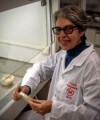Actualidad
Carvacrol: A Natural Inhibitor of Alternaria alternata Infection in Diverse Crops
Integrated transcriptomics and proteomics analysis reveals inhibitory effect of carvacrol on Alternaria alternata by interfering with carbohydrate metabolism

Fungal infections are the main reason for the deterioration of fruits and vegetables after harvest, causing significant economic losses. They can also occur during transport, which later, during storage, alter fruit quality. One of the main agents responsible for these infections is Alternaria alternata (Ascomycota) which causes decay and dark spots on a wide range of crops, both on fruits and leaves and various other parts of the plant.
During the infection process, A. alternata also produces toxins such as tenuazonic acid, alternariol, alternariol monomethyl ether, allenene, tentoxin and altertoxins, which can be harmful to human health.
A highly effective method to prevent the growth of postharvest pathogenic fungi is the use of synthetic fungicides. However, the application of such additives can generate chemical residues, resistance to plant pathogens, environmental contamination, and health problems.
Carvacrol, an essential oil from oregano and thyme
Extensive research has shown that plant essential oils can be very effective in reducing postharvest fruit diseases and preserving fruit quality while maintaining safety.
Carvacrol, also known as 2-methyl-5-(1-methylethyl) phenol, is a liquid phenolic monoterpenoid found in oregano and thyme essential oils. It is widely used as a flavoring agent and for its antimicrobial properties, and has been approved as a safe food additive.
Several studies have shown that carvacrol inhibits in vitro the growth of pathogenic fungi such as Candida albicans, Aspergillus flavus, Penicillium verrucosum, Botrytis cinerea, Aspergillus westerdijkiae and Fusarium verticillioides as well as Alternaria alternata,
Effects on the cell wall of A. alternata
A previous study observed that the immediate effect of carvacrol against A. alternata is due to interference with cell wall construction, resulting in a deterioration of the integrity and loss of its permeability.
The fungal cell wall consists of a core of covalently bonded branched β-(1,3)-glucan and chitin, which maintain their structure and resist external stress. Disrupting carbohydrate biosynthesis is a promising and highly specific approach to develop new types of therapeutic agents.
Previous research verified that carvacrol treatment alters the metabolism of cell wall polysaccharides in A. alternata hyphae.
Effects on cell wall carbohydrates
In a current study, genes and proteins involved in carbohydrate metabolism after carvacrol treatment were analyzed using transcriptomic and proteomic data.
In addition, the expression of genes related to carbohydrate metabolism was analyzed using quantitative real-time PCR (qRT) when different concentrations of carvacrol were applied.
Carvacrol was found to reduce cell wall thickness, chitin and β-1,3-glucan distribution, glycogen accumulation and total content of the sugars trehalose, mannose, fructose and galactose.
Further transcriptomic and proteomic analyses revealed that carvacrol treatment accelerates the breakdown of cell wall polysaccharides in fungi, hinders sucrose consumption, disrupts the glycolysis pathway, and promotes the breakdown of carbohydrates related to fungal resistance to stress.
These results indicate that carvacrol affects carbohydrate metabolism, which is associated with the development of A. alternata, and provide information for developing natural fungicides to control postharvest diseases in fruits and vegetables.
Source
Zhao, L.; Wang, J.; Zhang, H.; Zhou, Y.; Wang, C.; Wang, P.; Wei, Z.; , Li, H.; Ding, Y. (2024). Integration analysis of transcriptomics and proteomics reveals the inhibitory effect of carvacrol on Alternaria alternata by interfering with carbohydrate metabolism. Postharvest Biology and Technology, 213: 112928.
Picture
https://ephytia.inra.fr/pt/D/694 Access on 24/06/24.













